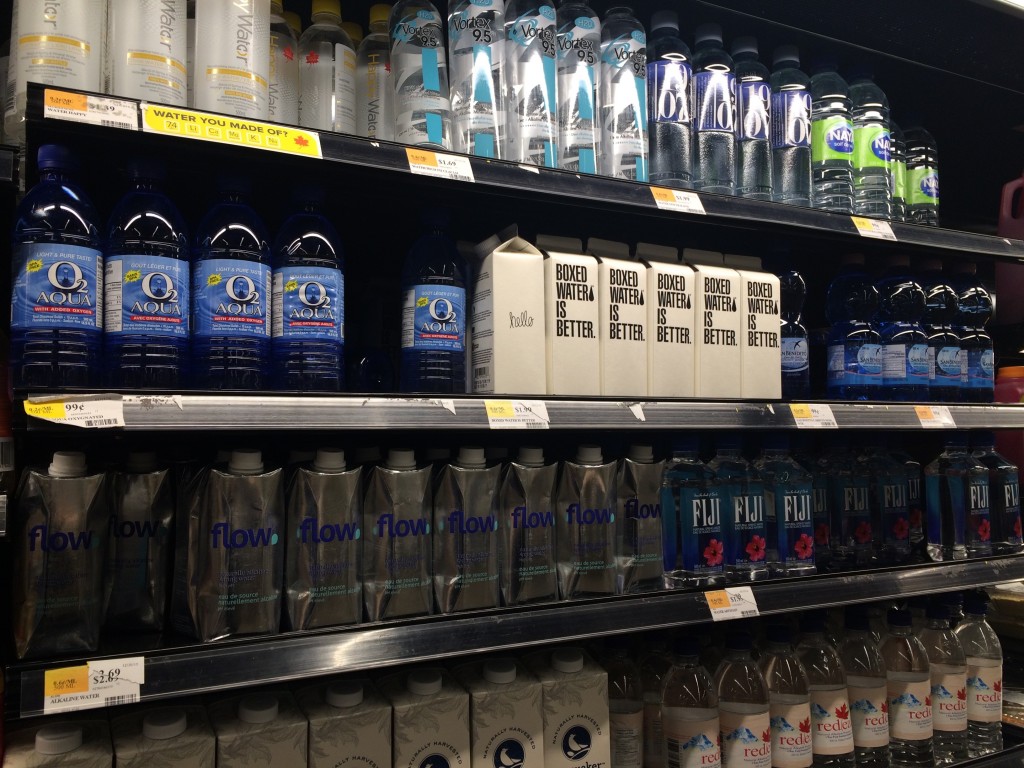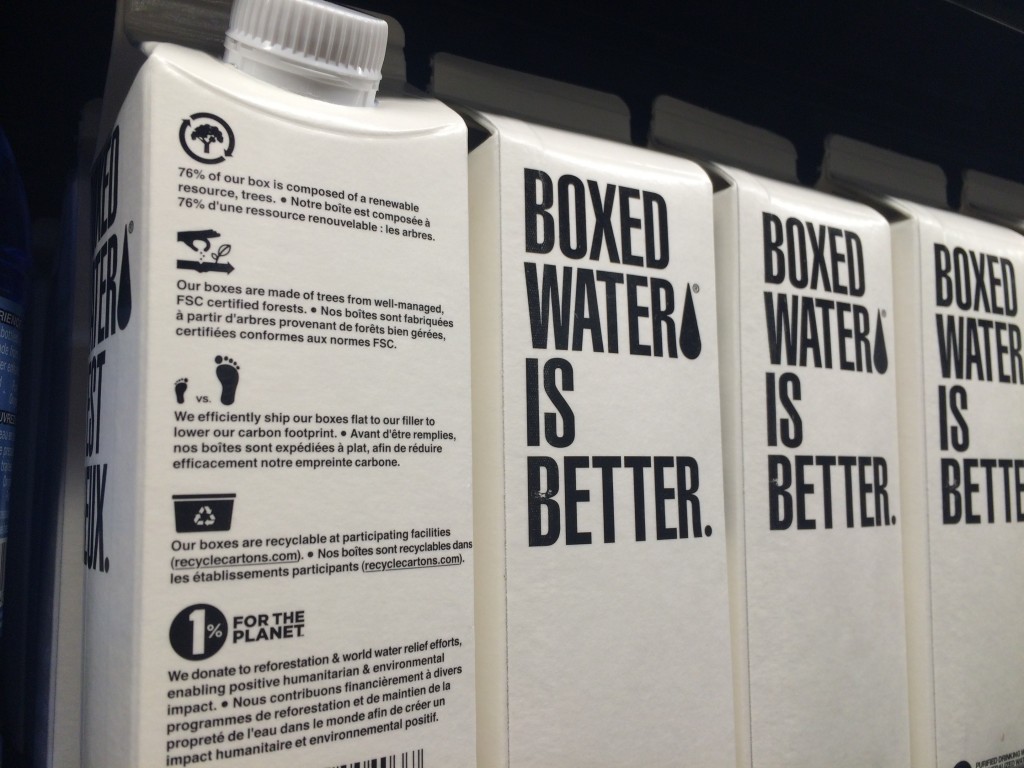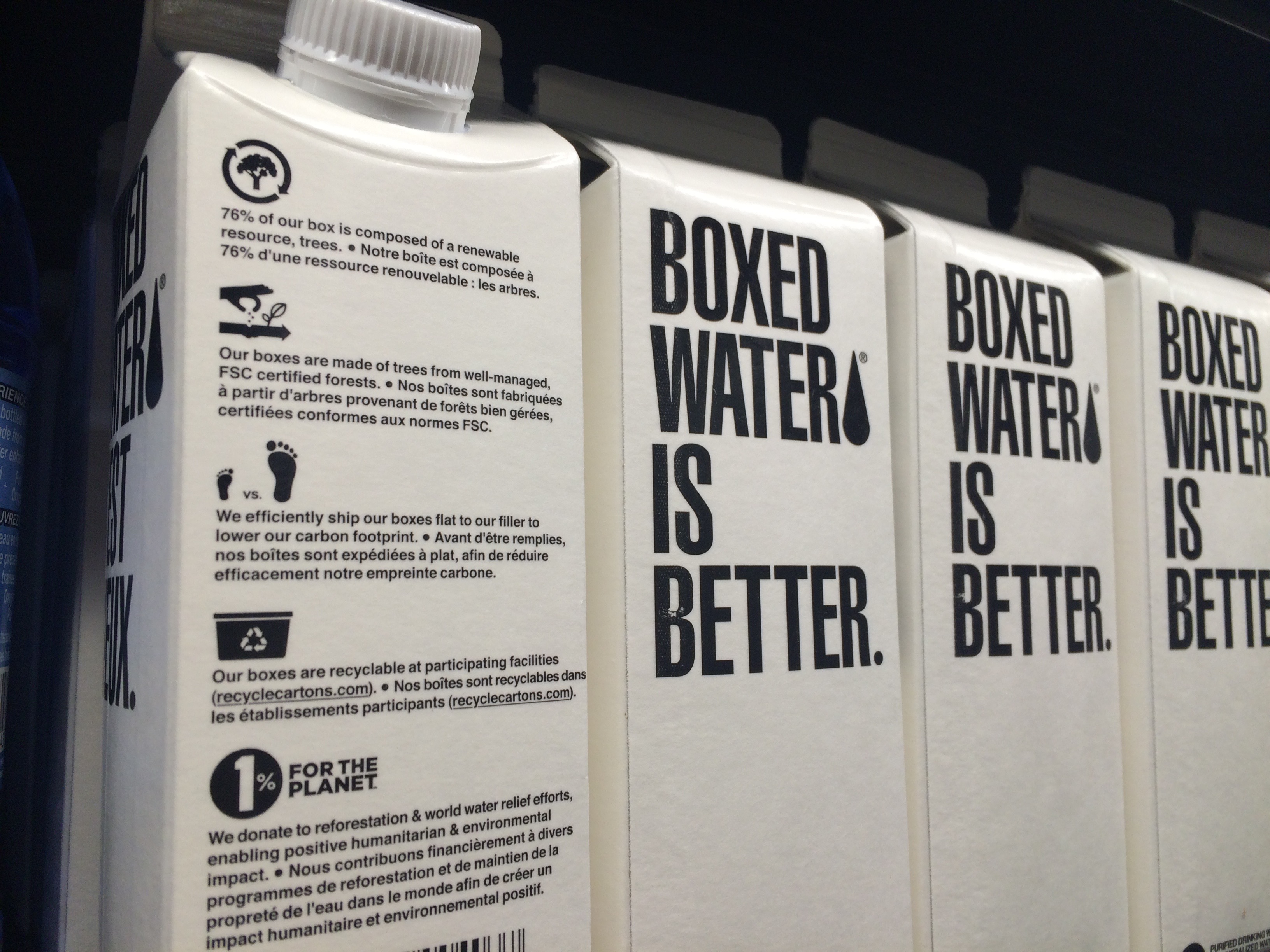Many people are now buying water in bottles rather than drink straight from the tap because bottled water has been perceived to be safer and of higher quality than tap water, and it was viewed as a healthful alternative beverage to soft drinks or alcohol. Although purity marketing successfully increases sales of bottled water, it failed to address that plastic water bottles waste our environment.

One company takes a bold and interesting step forward. Water is in paper boxes and its brand name is “Boxed Water Is Better.” The package says boxes are better than plastic bottles for several reasons.
- 76% of our box is composed of a renewable resource.
- Our boxes are made of trees from well-managed, FSC certified forests.
- We efficiently ship our boxes flat to our filler to lower our carbon foot print.
- Our boxes are recyclable at participating facilities.


During a trip to Italy, I came across a paper-packed wine at a mart, just like milk. The first time I saw it, I thought the idea was great, but I didn’t really want to buy it. Why did I think that?
With the global eco-friendly issue, the food and beverage industry is also moving to use paper packaging instead of plastic bottles and glass bottles. The post describes the design of green packages and introduced a product called “Boxed Water Is Better” as an example. The packaging is said to have been made for environmental protection purposes, such as reducing the carbon footprint and increasing recycling rates by using paper packs. Liquor industries such as wine, vodka, and whiskey have also shown great interest in paper bottles since 2020. And many brands have announced that they will completely shift to paper bottle packaging within the next few years. However, is there no resistance to the drastic change beyond the ‘Just Noticeable Difference’ from the perspective of consumers? Clearly, I was a little bit reluctant when I first saw the paper-packed wine in Italy.
The reluctance arising from this sense of difference between paper packaging and wine may be related to consumers’ attitudes toward wine. Especially in Korea. As wine became more common in Korea, it became a popular drink in everyday life. However, wine still has the impression that it is expensive and luxurious. Therefore, consumers will feel a sense of disjunction when they see wines with luxurious images packaged in light paper packs. This is because they want to maintain consistency in their emotions, cognition, and behavior. In Korea, it is easy to see people enjoying wine more than other alcoholic beverages to enjoy the atmosphere on special days. In other words, wine does not go well with light packaging because it makes them feel more luxurious than soju or beer. So, consumers will prefer glass-bottled wine. This is because the weight of the glass bottle can further enhance the luxuriousness in line with the image of the wine. In fact, consumers interpret the weight as luxurious. Therefore, from a marketing perspective, we propose the following to various liquor brands. In the process of changing packaging to a paper bottle, we should start by changing only the material very similar to the existing design so that it does not exceed the consumer’s minimum identification difference. If it’s alcohol that comes in a transparent glass bottle, you’ll have to design the packaging in a color similar to the color of the alcohol. And companies have to make great efforts to break down consumers’ prejudice against paper. Already, consumers have come to realize that paper straws are uncomfortable. Also, the fact that paper straws are not actually eco-friendly may have further strengthened the negative bias. They should be careful of the representative heuristic that paper-based products are likely to be uncomfortable. This is because paper straws are representative because of the same characteristic of ‘paper’. That’s why they should emphasize to consumers that paper bottles are not functionally different from glass bottles.
In conclusion, I felt a sense of difference because the light image of the paper did not match the luxurious image of the wine. That sense of difference soon made me feel rejected to want to choose wine in a paper package rather than glass. And the consumption experience learned with paper straws reinforced the negative feelings about paper packages. Therefore, in the liquor industry, it is important to break away from the prejudice that paper has a light image and discomfort. In order to change the packaging to a paper bottle without consumer resistance.
News about environmental pollution and climate change due to global warming is spreading every day. Consequently, consumers who consider the ‘environmental impact’ of products have increased, and the marketing industry has begun to perceive this as a ‘Needs.’ As a business student studying ESG management and a consumer who separates garbage for recycling, I find this case quite interesting. This case points out that plastic water bottles contribute to environmental waste as part of purity marketing in the bottled water industry. In response, it introduces ‘Boxed Water Is Better,’ explaining on the product package why a paper box is environmentally better than a plastic bottle. By presenting this ‘Consumption Vocabulary’ of ‘environmental protection,’ consumers can form their preferences when companies provide it. Thus, this product enables consumers to consider this ‘Vocabulary’ in their decision-making process.
The ‘Needs’ of consumers for environmental protection are increasing, making it a ‘vocabulary’ in itself. Consequently, companies in various industries have begun to launch products that aim for environmental protection to reflect this trend. Analyzing this case led me to think about recent developments in the K-pop industry regarding ‘Platform Album’. The era of CDs is over, and most people now listen to music through online streaming services. Nevertheless, K-pop consumers still purchase physical albums containing CDs, citing reasons like ‘wanting to own albums of their favorite artists’ or ‘wanting the goods included in the albums.’ Especially, the ‘Goods’ that randomly include various photos of the artist (using a variable-ratio schedule) keep the version unknown until the album is opened, and these are included in limited quantities. So, if fans want a particular goods or want to collect all goods, they need to purchase a large number of albums. This process results in a massive amount of discarded items (including CDs) besides the goods. While the industry has generated business effects such as increased sales by including ‘goods’ in physical albums, it worsens environmental pollution. In response, the ‘Platform Album’ emerged as an alternative. A platform album is a type of digital album that provides music in the form of digital content. It consists of a QR code/NFC that allows consumers to download or stream music on a proprietary player and simple goods that meet strong consumer needs. It prevents unnecessary plastic and paper waste excluding other components(including CDs). (Examples: Weverse Album of HYBE Entertainment, Smini of SM Entertainment, etc.)
As a consumer who has been a fan of K-pop artists for a long time and owns dozens of albums, I believe that the platform album is a good option for both consumers and companies. In a survey targeting K-pop fandom, nearly 70% of respondents answered that excessive album purchases have a negative environmental impact. The platform album adds the vocabulary of ‘environmental protection’ to the existing album, forming a new preference among consumers. Even those who did not previously consider the environment can newly recognize this vocabulary, and it also meets the needs of consumers who already consider it. Therefore, this product is attractive to consumers who want to own their favorite artist’s album while being conscious of environmental protection. In fact, most respondents in the survey had a positive perception of this. Moreover, platform albums are consumed without resistance even by consumers who do not highly value environmental protection. Particularly, consumers in the entertainment industry (fandom) have a strong attachment to artists, leading to a severe ‘Bias’. Consumers tend to focus excessively on specific elements that determine their emotions when predicting future experiences (Focalism). Fandom purchases albums just because their favorite artist released them, without considering other factors (such as price or practicality). I consider this form of the album as a ‘Default Option’ mentioned in ‘Status Quo Bias.’ Even if CD albums are replaced by platform albums, consumers will buy them regardless of the format because it is the default configuration of an album released by a favorite singer. Thus, consumers reduce waste emissions unknowingly by purchasing this product regardless of their intentions. Therefore, just by releasing platform albums and replacing other CD albums with them, the industry can reduce waste emissions.
Of course, platform albums are not completely free from environmental concerns. Since entertainment companies pursue profit, they still include ‘Goods’ (using a variable-ratio schedule) for the sales increase in these albums and continue to release new albums, including CDs. However, I believe platform albums are sufficiently ‘Green’ as they continuously inform consumers about ‘environmental protection’ and actually reduce waste emissions. Not only in entertainment but also in other industries, it is necessary to have deep consideration for such ‘Green’ products. These new attempts should continue for the benefit of both companies and consumers. After all, we live on this planet.